Tropical storms
Tropical storms are intense low-pressure weather systems that bring strong winds, heavy rainfall and storm surges to some parts of the world.
Impacts of tropical storms
The primary impacts of tropical storms are:
- The immediate effects of strong winds, high rainfall and storm surgeSea level rises above the normal tidal range..
- Buildings and bridges can be destroyed, people can get into difficulties in the water, and roads and railways can become damaged.
- Power cables and telephone lines come down, crops are ruined, and water and sewage supplies are affected. Coastal habitats like beaches and mangrove forestTropical evergreen trees which help protect coastal zones. can be damaged by storm surge floods.
Secondary effects include:
- Landslides which can cause people to become homeless and can block roads and railways. This can cause evacuation problems and difficulties for the emergency services.
- There can also be food and clean water shortages.
Impacts in low-income developing countries (LIDCs)
As with tectonic hazards, the impacts tend to be greater in less developed countries for a number of reasons. Housing tends be of poorer quality, as is infrastructure (roads and railways), which makes it difficult to evacuate people and get emergency services to where they are needed. More people in low-income countries depend on farming, and have their livelihoods threatened, particularly by flooding.
Poorer countries do not have the money to protect areas from flooding, or to spend on modern buildings or emergency services like hospitals, ambulances and helicopters. Health care is also often short of the required medicines and expertise to deal with the aftermath of a tropical storm.
Responses to tropical storms
There are many ways of reducing the impact of tropical storms. When and where the storms will hit land can now be accurately predicted. Scientists use data from satellites, radar and aircraft to track storms. Computer models play their part, but this technology is not always available in low-income countries. Planning of new developments can avoid storm risk areas, and buildings can be designed to withstand the high winds and flooding, by having fixed roofs and using stilts or raised banks. Flood defences called levees can be constructed along rivers and at the coast, sea walls can be used to hold back storm surges.
Governments can provide education and information about evacuation and survival kits, and international aid such as food, water, shelter and emergency services from developed nations can help after the event has occurred. Obviously, some of these methods are more likely to be successful in the wealthier countries.

Why do people live in hazardous areas?
People continue to live in areas prone to tropical storms for a number of reasons. They may want to stay close to friends and family, or have jobs they cannot leave. Hazard perception is an important issue -- some people think they are safe and that the storms will never affect them. In advanced country (AC)A country that has well-developed financial markets, rapidly growing service sectors and diverse economic structures. there is often a feeling that the wealth and technology of the home country will deal with any disaster that hits.
There is some evidence to support the theory that global climate change is leading to increased frequency of tropical storms around the world.